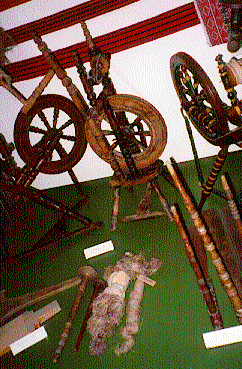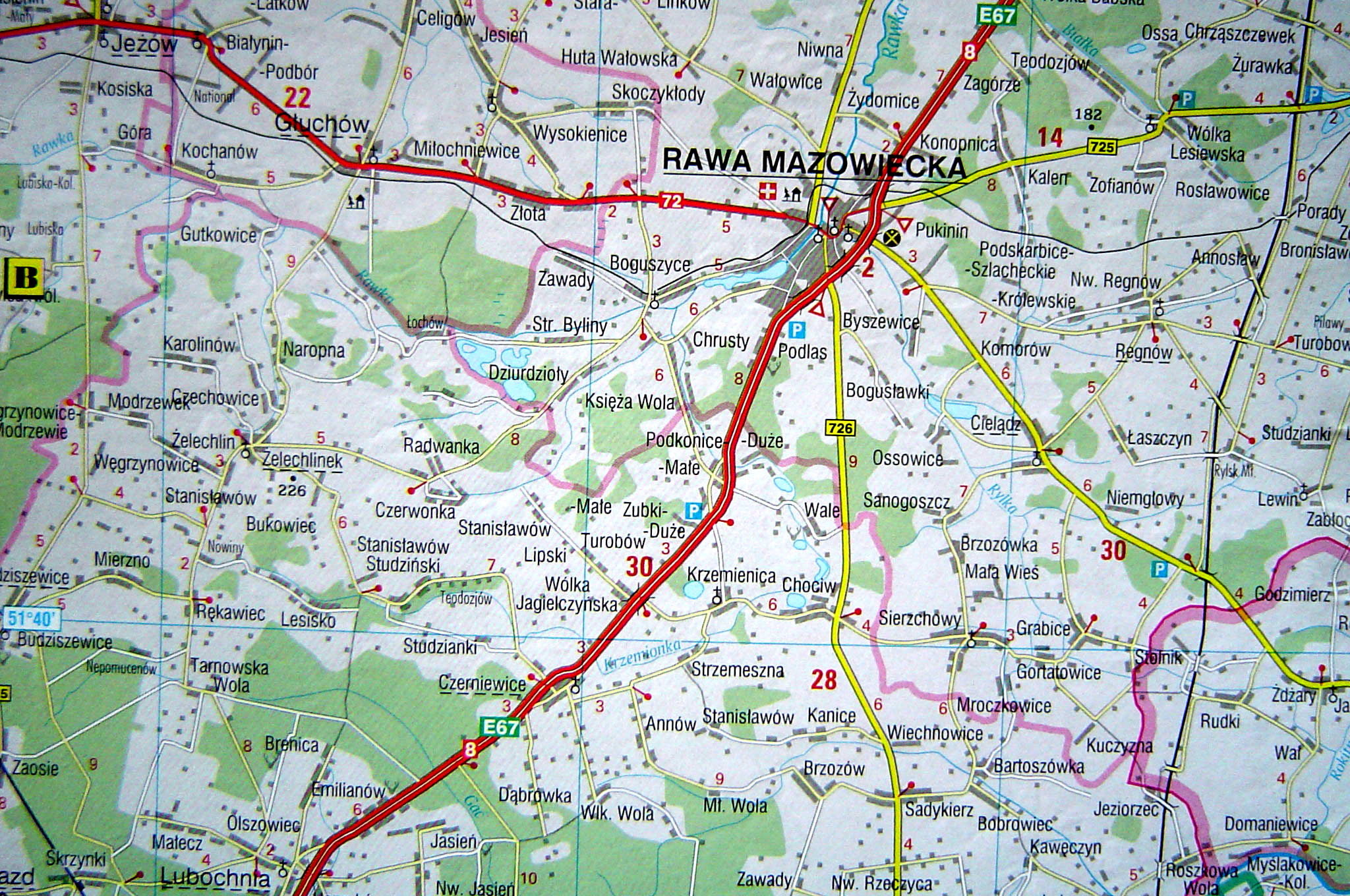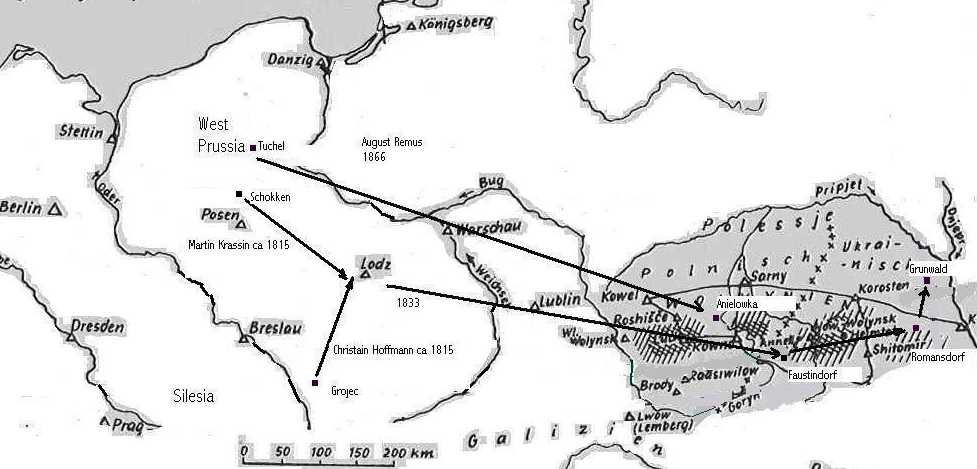
A FAMILY HISTORY FOR THE
HOFFMANN, LEHMANN, SPTIZER, AND RELATED FAMILIES IN OLD VOLHYNIA
By Bill Remus
Prehistory of the Hoffmann Family
Like much of the Midwest US and Canada, many areas of Germany and Poland were formed by glaciers. This means that in many areas the topsoil has been removed and only sandy alkaline soil remained. So life for peasant farmers was difficult; peasants had only a few meager crops to support their family. To provide addition income, peasants grew flax. Flax provided grain, oil and the fiber from the plant could be used to make linen thread. Those making linen cloth are referred to in German as tuchmachers.
To process the flax, first flax oil was first extracted from the head of the flax plant. The remainder of the head was often fed to the livestock (although it could be used for people too). The straw from the flax was then immersed in damp soil so the outer coating of the straw deteriorated. The fibers remained and were spun into yarn. The yarn could be sold or wove into ribbon or cloth. The picture following shows flax yarn and the spinning wheels to make the yarn.

As is clear from the above flax growing and processing can supplement one's income and can involve the whole family whenever free time is available. Until the mid-1800's linen was produced in this cottage industry way. However, the tuchmacher process remained even when automation caught on. Here is Eric Hoffmann's description of the process used in the Hoffman family:
"Farming was of the diversified type. They raised a little of most of the things needed for human consumption; such as rye, wheat, buckwheat, peas, beans, potatoes, but no corn. Garden vegetables were of the usual varieties. Flax was raised quite extensively. After the oil was extracted from the seed the pulp was fed to the cattle. The straw was tied in bundles and then placed in shallow ponds where it was allowed to lay until the stalks were quite soft and brittle. The straw was the taken out of the water and allowed to dry. When thoroughly dry, it was stored in the their barns. Later on when all outdoor work was done the fiber part of the straw was separated from the stalks. This was done by grasping a bunch of flax stalks with one hand and then using a short stick and beating the protruding ends until the pulpy part was separated from the fibers. The fibers were then thoroughly combed and spun into thread for the making of cloth for clothes. This work was done mostly by the women during the winter months. The men and boys also helped with the separating of the flax fiber from the straw and the carding of the wool."
Around 1810 business was really good for tuchmachers in Saxony and around the Posen area of Prussian Poland. Napoleon and his Saxon allies needed good linen uniforms for their military. Saxony and Posen were a good places for cloth production as the French industry was decimated by the French Revolution. But when Napoleon was defeated and the French cloth industry was back in production, the demand for linen cloth was drastically reduced.
Meanwhile the Polish nobles near Lodz saw a way to make use of their sandy alkaline lands. They invited tuchmachers from Saxony and Posen to move there and begin linen production. The economic reason the Nobles invited the tuchmachers was that cloth made in the Lodz area was duty-free inside Russia whereas cloth made in Saxony and in the Posen area was subject to prohibitive tariffs.
Ozorkow is a very good example of a village established for tuchmachers.It is important to note that many of the tuchmachers in the Posen area had been recruited by the Prussian government from Wurtemburg and Baden. The Hoffmann, Reiser, and Spitzer families most likely came from Wurtemburg and Saxony but were in the Posen area by 1800.
My great-great-great-grandfather Christian Hoffmann was born in Krolikowo near
Krolikow in Grudziec parish (the alternative is Krolikowo near Schubin). He moved to the Stanistowow Studnizski near Rawa, Poland around 1820. His wife Anna Rosine Hahn (born in Nekla near Posen) are her family also moved to the Rawa area. They married in Czerniewiec and had their first children in Stanistowow Studnizski; both villages were near Rawa, Poland including my great-great-grandfather Samuel. Stanistowow is halfway between Rawa and Petrikau on E67 so is "near Petrikau" as described in Eric Hoffmann's family history. See the map below. Their children were Daniel (b. 1821), Gottfried Friedrich (b. 1825), Anna Helena (b. 1827), Anna Rosina (b. 1830), Samuel (b. 1833), and Caroline (b. 1836). They arrived in Volhynia in 1835.
By 1800 Andreas Spitzer was also in the Posen area. His wife Anna Justine Mandelski was born in Czabuninka (probably
Czamanin Kolonie) in parish Radziejow. Their second child Andreas was born in Sosnowa Wola in that same parish; their fourth child Anna and fifth child Gottfried were likely born in Blenna. The other children were undoubtedly born in the area. The children were confirmed in Rawa. They arrived in Volhynia in 1835.The Johan Martin Will family married into the Spitzer family. Martin was born in Kolonie Kulkowa near Rogasen, Posen (sorry no pictures) and his wife Anna Dorothea Schendel was born in Neudorf near Bartchin, Posen (the next village south was
Szczepanowo). Their second daughter Anna Susanna and third daughter Anna Caroline were born in Kostrzyn, Schwersenz, Posen. So this family was also from the Posen area. The daughters were confirmed in Rawa. They arrived in Volhynia in 1835.The Johan Krassin family came from the tuchmacher village of
Schokken, Posen area. His son then settled his family near Schwersenz, Posen area prior to migrating to Volhynia. Martin's daughter Anna Rosina married Friedrich Hahn; Friedrich was born in Bycz. They also arrived in Volhynia in 1835.The Lehman family were specialized tuchmachers (they were
weavers) and probably from Posen too.The Reiser family can be traced back to
Feuerbach and Degerloch near Stuttgart in Wurtemburg. From there they migrated to Volhynia via Gruenberg (sorry no pictures) and Bessarabia (again no pictures). Like all the above folks they ended up in Faustindorf (see below).
In 1830 the Poles revolted against their Russian masters in a particularly nasty revolution. The Russians put down the revolution and punished the Poles in many ways including putting up the tariff barrier on cloth. When eventually the tariff barrier came down, cottage industry cloth making was dead in Poland. When the industry restarted, the cottage tuchmacher was replaced by industrial production and linen was replaced by cotton. Lodz became famous for its cotton textiles.
Meanwhile, the nobles in the Ukraine observed that cloth from Lodz was expensive in Russia due to the post 1830 revolution tariffs. The nobles invited the tuchmachers to move from Poland to Volhynia. The cloth manufacturing would be again inside the Russian tariff barrier and thus profits could accrue to the nobles of the Ukraine.
Faustindorf
The Christian Hoffmanns, Andreas Spitzers, Martin Wills and allied families arrived in Friedensfeld, Volhynia (half way between modern Miripol and Romanow) in 1835; click on the
1835 Kirchenbuch Record to see who all arrived that fateful day. They came to make cloth. They initially lived in nearby Justinowka.A Count Chapsky had land fairly close to Justinowka and offered it to Germans and Poles on 20-year contracts (the first few years were free as you cleared the land and began to farm). The more famous village of Stanislowa (named after Chapsky's son Stanislaw) was established in the center of a region of sandy alkaline soil; this village drew many Germans.
Also the nearby village of Faustindorf was established. It had the sandy alkaline soil necessary for flax and was on a slope leading down to wetlands necessary to process the flax. Both Stanislowa and Faustindorf were street villages (strassendorf). That is, there was one straight street in the village with the houses neatly built next to each other. The map of Romansdorf later on shows this in more detail. They moved on en masse to Romansdorf in 1855.
My great-great-great-grandfather Christian Hoffman, Andreas Spitzer, and related tuchmacher families moved to Faustindorf by 1836 (although a few settled in Slanislowa). These villages are about 35km south west of Zhitomir not far off the main road as shown in the following map. The church book (Kirchenbuch) for some of their years in Faustindorf is available on microfilm from the Mormons.
Alt Sapust, Alt Dubisch, and Tarnawola
The Radkes, Krassins, Kurtz, and related tuchmacher families were from the Alt Sapust area. Like Faustindorf, these villages were on sandy alkaline soil suitable for growing flax. They were also on the Styr River so the mud flats were suitable for processing the flax straw to extract the linen fiber.
The German tuchmachers arrived in the Alt Sapust area about the same time as the German tuchmachers arrived in the Faustindorf area. In both cases the tuchmachers first resided in the Lodz area (the Hoffmans in Stanislowow, Rawa and the Krassins in just west of the Hoffmans in Laskowice) before moving on to Volhynia around 1835. The two groups of people were linked by teacher Jacob Reiser in Faustindorf and his sister Juliana Lehmann (nee Reiser) in the Alt Sapust area. The church book (Kirchenbuch) for some of their years in the Alt Sapust, Alt Dubisch, and Tarnawola area is also available on microfilm from the Mormons.
The Alt Sapust, Alt Dubisch and Tarnawola group did not move en masse to Romansdorf as did the Faustindorfers. In fact, the majority of these families stayed put including parts of the Krassin and Spitzer families. The move by those from Alt Sapust, Alt Dubish, and Tarnawola seemed to be more by virtue of marriage or occurred as their numbers exceeded the available farmland in that area. In the Gallery below there are pictures and details of this area.
Gallery of Alt Sapust and Nearby Villages
Below is a map showing the move from the Lodz area to Faustindorf/Stanislowa to Romansdorf and ultimately to Grunwald. The tale of the last two moves will follow a description of how our ancestors lived while in Volhynia. Also in the next web pages are details from the family trees of the families mentioned above.

Hard to Read the Map?
Click here for the Adobe Acrobat Version.
Housing for Our Ancestors
The housing in this and other German villages is pretty much still as described by Eric Hoffman in his family history:
"Each family had a small plot of ground around their home for a garden and a yard or pen for their stock. A herder was employed by the whole village. Each evening he rounded up the cattle and took them out to pasture in the country and brought them back in the evening. The house and barn was a one-unit affair. The family or owner lived in one end of the building and the livestock was housed in the other. There of course was a wall to seal off the stable part from the family living quarters. In the part of Russia where our folks lived the farmers were plagued by horse thieves. So when they built their barns, no doors were made to lead directly into the part where the livestock were housed. The animals were driven or led through a door and across the corner of one of the rooms of the house. Even then the people had to be on the alert lest the thieves might cut a hole through the other end of the building and steal their horses. The household furnishings were very plain - mostly hand made. A fireplace was used to heat the house and clay ovens for baking bread. Cook stoves as a rule had sides made of brick or clay with cast iron tops."
The gallery contains pictures of such houses. The first shows the general design of a tuchmacher house including the walls of squared-off logs and gabled roof; this one is in Alt Sapust where the Radkes originally lived. The second picture shows the roof of the time - thatch. The third shows the one central door for both people and animals. Another shows the outdoor oven so you didn't burn down the house.
Gallery of Houses in the Ukraine
Click here to move on to Romansdorf
Please send any queries to Bill Remus at
Updated on February 29, 2008.